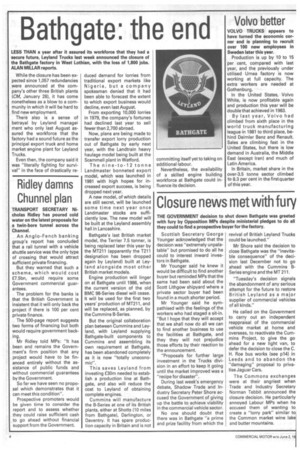Bathgate: the end
Page 6

If you've noticed an error in this article please click here to report it so we can fix it.
LESS THAN a year after it assured its workforce that they had a secure future, Leyland Trucks last week announced the closure of the Bathgate factory in West Lothian, with the loss of 1,800 jobs. ALAN MILLAR reports.
While the closure has been expected since 1,057 redundancies were announced at the company's other three British plants (CM, January 28), it has come nonetheless as a blow to a community in which it will be hard to find new employment.
There also is a sense of betrayal by Leyland managet. ment who only last August assured the workforce that the factory had a sound future as the principal export truck and home market engine plant for Leyland Trucks.
Even then, the company said it was "literally fighting for survival" in the face of drastically re duced demand for lorries from traditional export markets like Nigeria, but a company spokesman denied that it had been able to forecast the extent to which export business would decline, even last August.
From exporting 10,000 lorries in 1979, the company's fortunes had declined last year to sell fewer than 2,700 abroad.
Now, plans are being made to transfer export lorry production out of Bathgate by early next year, with the Landtrain heavy haulage model being built at the Scammell plant in Watford.
The nine-to-1 2 tonne Landmaster bonneted export model, which was launched in 1981 with high hopes for increased export success, is being dropped next year.
A new model, of which details are still secret, will be launched some time next year once Landmaster stocks are sufficiently low. The new model will be built at the Leyland assembly hall in Lancashire.
Bathgate's last British market model, the Terrier 7.5 tonner, is being replaced later this year by the MT211 (apparently the T211 designation has been dropped again by Leyland) built at Leyland alongside most other British market models.
Engine production will linger on at Bathgate until 1986, when the current version of the old BMC 98-Series diesel will cease. It will be used for the first two years' production of MT211, and will be replaced, as planned, by the Cummins B-Series.
But the original collaboration plan between Cummins and Leyland, with Leyland supplying Bathgate-built components to Cummins and assembling its own requirement at Bathgate, has been abandoned completely as it is now "totally uneconomic".
This saves Leyland from investing £30m needed to establish a production line at Bathgate, and also will reduce the cost to Leyland of obtaining complete engines.
Cummins will manufacture the B-Series at one of its British plants, either at Shotts (10 miles from Bathgate), Darlington, or Daventry. It has spare production capacity in Britain and is not committing itself yet to taking on additional labour.
Nevertheless, the availability of a skilled engine building workforce at Bathgate could influence its decision.
























































































